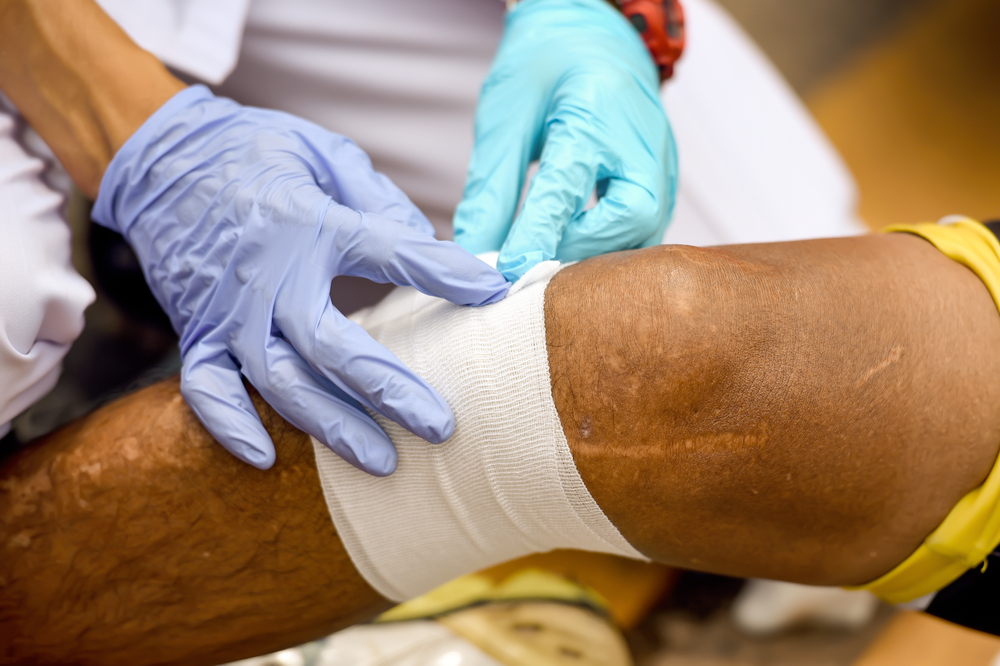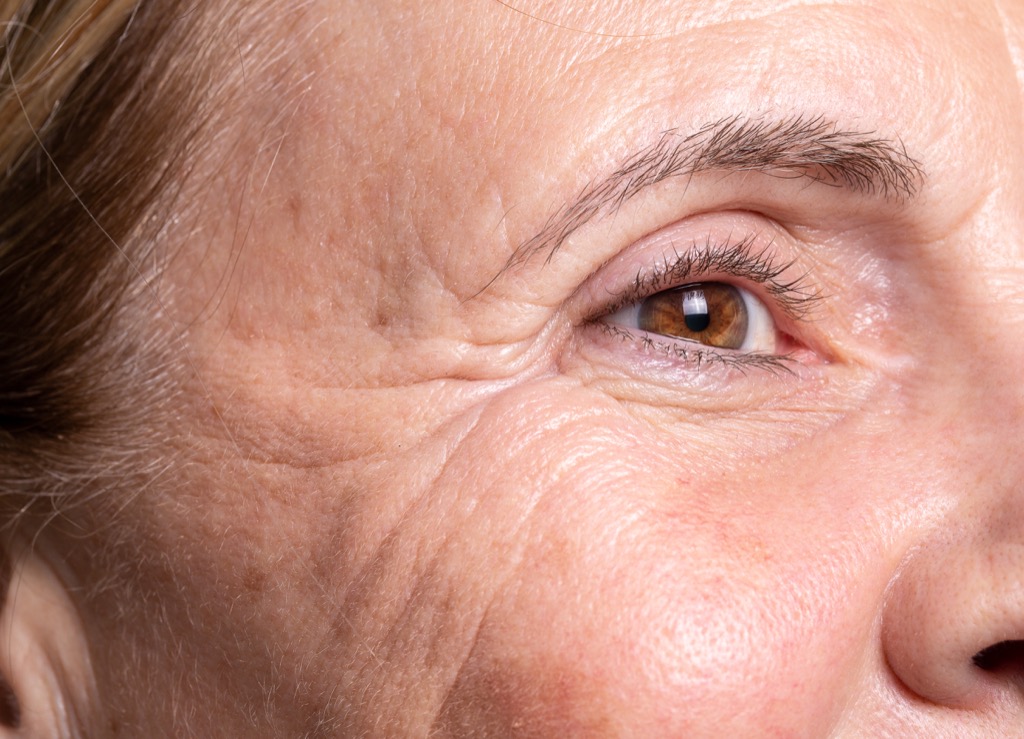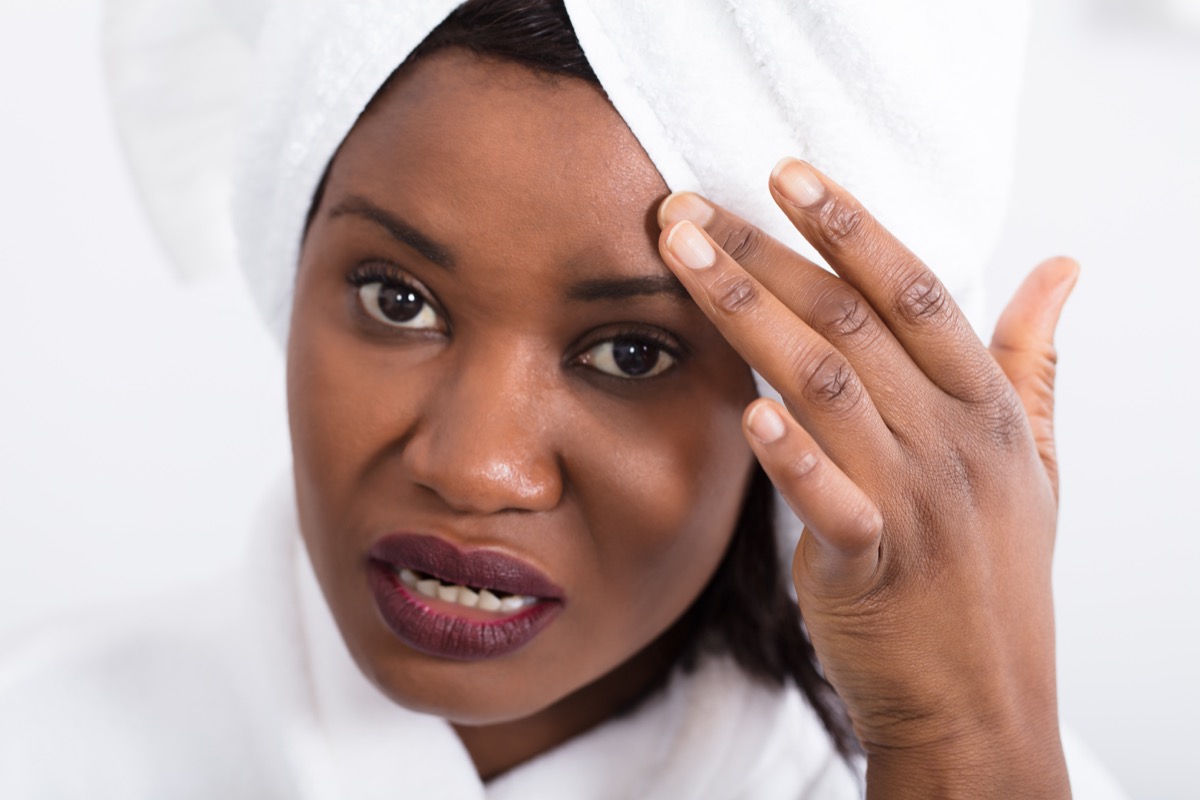By the time you reach 40, you’ve probably already noticed gray hairs here and there. However, this is nothing to worry about. According to The Library of Congress’s science reference pages, this is merely the result of a natural decrease in the amount of melanin your body is producing. And for more on getting older, check out The Biggest Myth About Aging You Need to Stop Believing.
Nearly everyone will experience some sort of hair loss as they get older. In fact, 40 percent of women will see visible hair loss by the time they reach 50, according to a 2015 study published in the Journal of the American Academy of Dermatology. This hair loss is due to age-related hormonal changes, which alter the regrowth rate of hair. While adults over 40 continue to lose hair at a normal rate—around 50 to 100 strands per day—the time it takes for them to grow these strands back increases with age.
If you’ve had to stop by the local drugstore recently to pick up a pair of readers, you’re not alone. Starting in your early- to mid-40s, your eyes become more easily strained when reading or using screens. According to the American Optometric Association (AOA), this change is called presbyopia, and it is completely normal. Regular trips to the ophthalmologist, however, can help you keep your eye health in check. And for more on what changes in your vision can mean, check out 17 Warning Signs Your Eyes Are Trying to Tell You About Your Health.
Sadly, there’s no getting around the fact that your ears won’t work as well as you age. Approximately one in three people in the United States between the ages of 65 and 74 have hearing loss, according to the U.S. Department of Health.ae0fcc31ae342fd3a1346ebb1f342fcb However, while some cases of hearing loss are hereditary or linked to disease, others are due to environmental factors. People exposed to excessive loud noises, for instance, may begin to notice their hearing decline as early as their 40s. Similarly, the Mayo Clinic notes that working in a loud environment, like on a farm or on construction sites, “can lead to damage inside your ear.” As you get older, your larynx—or voice box—undergoes changes. That’s because “the vocal cords, or folds, lose their flexibility [and] elasticity and can atrophy. In addition, the vocal folds dry out,” explains Inna Husain, MD, assistant professor in the department of otorhinolaryngology and section head of laryngology at Rush Medical College. These changes can cause your voice to sound weaker and less predictable. Add in the hormonal changes that occur with menopause, and Husain says that female voices tend to get lower over time. Male voices, meanwhile, do the opposite. According to Husain, your pharyngeal—or throat—muscles also weaken as you age. “There are some neurosensory changes … [that] can cause poor coordination between the oral phase of swallowing and the pharyngeal phase of swallowing,” she explains. This makes it more difficult for the throat to discern between liquids and solids, and so you might notice that you have more difficulty swallowing after 40. And for helpful health information, sign up for our daily newsletter. “The highest [risk of] developing a herniated lumbar disc is among people aged 30 to 50 years old,” says orthopedic surgeon Erin Nance, MD. Common symptoms include lower back pain and pain that radiates into your buttocks and legs. The good news? According to Nance, rest, physical therapy, and anti-inflammatory medications are all effective treatments. “The majority of patients will have improvement in their symptoms within three months.” And for more on aches that you shouldn’t overlook, check out 25 Common Pains You Should Never Ignore. Although you can develop carpal tunnel syndrome at any point in your life, the Cleveland Clinic notes that “the chance of getting carpal tunnel syndrome increases with age.” According to Nance, “tingling of the thumb, index, and middle fingers and nighttime pain” are common symptoms, so make sure to watch out for these warning signs as you get older.
Oral hygiene is often overlooked, but skipping the dentist is not a risk you should take, especially once you’re over the hill. As you age, lower bone density can lead to receding gum lines in the mouth, which leave the roots of your teeth more vulnerable to decay. Some tips for preventing root decay are to brush often, drink tap water (which often has fluoride in it), make regular trips to the dentist, and—as you’ve heard a million times—floss.
It’s not all bad news regarding your oral health once you’re middle-aged. For instance, you’ll probably find that your teeth become less sensitive by the time you enter your 50s. This is because, over time, the nerves in your teeth get smaller and are therefore less reactive to stimulants. This might make it easier to bite into an ice cream sandwich, but beware: It also makes you less likely to notice any cavities.
Everybody shrinks as they age. Due to loss of bone density as well as muscle mass, it’s inevitable. However, the rate at which people get shorter varies depending on factors like gender and lifestyle. Between 30 and 70, for example, the University of Arkansas for Medical Sciences notes that men are likely to lose about an inch, while women can expect to lose two. Then, after 80, it’s possible for both men and women to lose yet another inch. You can control the rate at which you shrink by maintaining good posture, limiting alcohol and caffeine intake, and eating a balanced diet.
As you age, your bones lose calcium and minerals which, in turn, makes them more brittle and prone to breakage. According to the U.S. National Library of Medicine, maintaining a well-balanced diet full of calcium and vitamin D can help prevent excessive bone deterioration.
Muscle loss is natural and unavoidable for all adults—and believe it or not, it actually begins at 30. However, sarcopenia—as this deterioration process is called—is slow-moving, so it typically doesn’t manifest until you’re in your 40s or 50s. Aside from physical appearance, typical symptoms include brain fog and decreased energy.
Sports injuries and pulled muscles aren’t as easy to get over once you reach a certain age. Due to a complex interaction of hormonal, biochemical, and physiological processes, the aging body requires more time order to heal muscle wounds. Thankfully, there is a way to keep up your active lifestyle into middle age and beyond. If you plan on being on your feet through your 40s and 50s, the American Council on Exercise (ACE) recommends integrating a generous amount of protein into your diet in order to aid muscle repair and growth.
Smell and taste are highly connected senses—so when one deteriorates, the other does as well. And sadly, age can play a factor here. According to the National Institute on Aging, age-related complications ranging from head injuries and nerve damage to Parkinson’s and Alzheimer’s can all lead to long-term smell impairment. Meanwhile, taste buds naturally die off slowly over time, making you less keen to pick up certain flavors and taste profiles.
If your joints are feeling more rickety these days, it could be a sign of osteoarthritis, a normal (and unfortunate) part of aging that involves the deterioration of the cartilage between bones. However, though this cartilage naturally wears down over time, it can also be aggravated by certain factors like hormonal imbalance, obesity, and chronic inflammation. If you’re dealing with joint pain, eating non-acidic foods, leading an active lifestyle, and buying orthopedic shoes are just a few ways to alleviate your aches. This is one major bonus about getting older. By the time you reach middle age, your body will have been exposed to the common cold and other similar viruses enough to have become naturally immune, as Jack Gwaltney, MD, an infectious disease specialist at the University of Virginia School of Medicine, explained to Everyday Health.
When it comes to drinking, once you hit 40, don’t expect to keep up with your colleagues in their 20s. In your later years, you’ll find that not only do fewer drinks get you drunk, but your hangovers are distinctly worse. These are both largely because of your liver’s weakening ability to metabolize alcohol combined with the decreased amount of water in your body. Limit yourself to one or two drinks a day if you want to avoid a serious headache the following morning.
Changes in sleep patterns are a totally normal part of aging. According to the U.S. National Library of Medicine, older adults tend to be less satisfied with their quality of sleep and report waking more frequently in the night. As internal medicine doctor Leslie Kernisan, MD, MPH, explained on the website Better Health While Aging, sleep troubles and insomnia can be indicative of underlying health problems associated with age as well. These include chronic diseases, osteoarthritis, and neurodegenerative disorders, to name a few.
If you’re having trouble thinking clearly, staying on track, or remembering even the tiniest things, you’re probably experiencing brain fog. Though this sort of mental fuzziness can occur at any time from stress, fatigue, depression, and blood sugar imbalances, it is more commonly seen in people over 40 as the result of age-related hormonal changes, notes Aviva Romm, MD, a physician and herbalist.
The brain begins deteriorating disturbingly early: just after it reaches maturity in your late 20s, according to a paper by Timothy A. Salthouse, MD, published in the journal Neurobiology of Aging. But the changes in the brain are hardly noticeable until you reach your mid-40s, when reasoning skills begin to slow down. According to research published in the British Medical Journal, reasoning skills drop 3.6 percent throughout your mid-40s and 50s. Once you hit 40, you should start focusing on keeping your brain sharp. Incorporate mind games into your daily routine, eat brain-boosting foods like kale and spinach, and hit the gym as much as possible.
As you age, your sweat glands change. A landmark 1987 study published in the Journal of Applied Physiology compared the physiological responses of postmenopausal women to younger women during a workout session—and the researchers found that older subjects had lower sweating rates. The study authors hypothesized that this is either due to “a diminished response of the sweat glands to center and/or peripheral stimuli” or “an age-related structural alteration” in the glands or skin cells.
According to a pivotal 2007 Postgraduate Medical Journal study, the muscle deterioration caused by aging weakens the muscles of the digestive tract, too, thereby causing digestive issues like heartburn, peptic ulcers, and irritable bowel syndrome. Unfortunately, age-related digestive troubles often trigger secondary conditions—but as is often the case, the solution to staving off such repercussions is steady exercise and healthier food consumption.
Now that you’re in your 40s, you’re going to have to decide whether that ice cream is worth the bloating, cramping, and diarrhea it might give you. But why does this happen? Well, a surprising number of people develop a lactose intolerance as they age. Specifically, according to the National Institute of Health, roughly 65 percent of people experience lactose intolerance later in life as the body’s levels of lactase, the enzyme that breaks down lactose, decreases.
There’s no denying that middle age hits women hardest, as this is when women first begin experiencing pre-menopause or perimenopause. Harvard Medical School notes that during this period, shifting hormones wreak havoc on women’s bodies, causing hot flashes, irregular vaginal bleeding and periods, and difficulty sleeping.
For women, the risk of developing breast cancer increases with age. In 2016, the Centers for Disease Control and Prevention (CDC) reported that about 188 per 100,000 women between the ages of 45 and 49 in the U.S. were diagnosed with breast cancer, compared to just 10 per 100,000 women between the ages of 25 and 29.
Not only does middle age bring on menopause and an increased risk of breast cancer, but it also complicates sex. With age, the body slows its production of estrogen—the hormone responsible for creating vaginal lubrication—and as a result, many older women experience painful vaginal dryness. This dryness can lead to painful urination, vaginal infections, and sensitive vaginal tissues. Shutterstock/Thampitakkull Jakkree Our hormones are volatile, especially in middle age. However, no hormone is more finicky than testosterone. The hormone is typically less prevalent in older males—and this can be a problem, seeing as it’s responsible for sex drive, sperm production, muscle mass, and energy. Though women experience a rise in testosterone as menopause hits, their levels eventually decrease, too.
Many older men experience an increase in the size of their prostate. In fact, according to the National Institute of Diabetes and Digestive and Kidney Diseases, 14 million men in the U.S. live with benign prostatic hyperplasia, or an enlarged and non-cancerous prostate gland, and most of them are over 50 years old. The primary symptoms of an enlarged prostate are urinary troubles and pain when climaxing. It can be treated in serious cases, but most people just have to get used to going to the bathroom more often.
Your decreased sex drive once you hit 40 is just as psychological as it is hormonal. At middle age, our bodies begin to change and social norms shift our focus toward slowing down instead of revving things up (i.e. retiring instead of chasing that promotion). These changes can lead to issues in self-perception, which can lower the libidos of men and women alike.
One oft-cited 1999 survey from the University of Chicago found that men between the ages of 50 and 59 were three and a half times more likely to experience erectile dysfunction (ED) than their 18- to 29-year-old counterparts. But, despite all the commercials advertising pills meant to treat ED, it’s not necessarily going to happen to you.
Unlike women whose fertility begins decreasing around age 35, men remain fertile well into their later years. Still, the chances of conceiving in middle age are not great for anyone. According to the Mayo Clinic, men over 40 are generally less fertile than their younger counterparts, as both sperm motility and semen volume tend to decrease with age.
Around 40, men and women alike begin experiencing changes in their skin, particularly in the face. As testosterone levels slowly drop, older men often notice their facial skin drying out and thinning, making wrinkles more apparent. The same goes for aging women, whose skin produces less oil as a result of lower estrogen levels. To combat sagging skin, make sure to moisturize thoroughly and often!
As the body undergoes its natural aging process, the skin on the face appears less taut over time. According to Harvard Medical School, this is because with age, fat loses volume and shifts downward, making previously round and tight features look loose and saggy. Along with wrinkles, sagging skin on the face is most apparent on the ears, near the jawline, below the eyes, and at the tip of the nose.
Once you hit 40, you become more likely to develop small spots in places that are often exposed to the sun, such as the face or hands. Called age spots or liver spots, these are believed to be the result of extensive UV exposure over time. Though they are almost always harmless, they can be removed if you find them aesthetically unappealing. “We start to see a common lesion develop [in people’s] 40s called seborrheic keratoses,” says Erum Ilyas, MD, a board-certified dermatologist in Pennsylvania. These rough “wart-like growths” are scaly and dry, and they’re most often found on the chest, on the back, on legs, and on arms. Though these lesions are harmless, some people opt to have them removed because they dislike how they look. However, Ilyas warns that though “they can be treated with cryotherapy in your dermatologist’s office, [they] often do grow back.” “Sedentary jobs and hormonal changes during the aging process can shift fat storage from the rear end to the stomach,” says Kathy Weber, MD, a sports medicine primary care physician with Midwest Orthopaedics at Rush. The result, unfortunately, can be a flat derrière that doesn’t fill out clothing quite like it used to.
Some of the more unfortunate muscles that weaken with age are the urinary tract muscles. That’s why most postmenopausal women and men over 40 experience urinary incontinence. In one 2015 study out of the University of California, Davis, researchers found that 68 percent of women between 42 and 64 experienced this issue.
Unfortunately for women, agonizing urinary tract infections can become a common occurrence both during and after menopause. Changes in vaginal architecture, a decrease in estrogen, and urinary incontinence all play a role in this problem.
If you’re feeling a bit rounder in the midsection than you’re used to now that you’re in your 40s, you’re not alone. Hormonal and lifestyle changes can lead to weight gain, especially in your 30s and 40s. And when it comes to those extra few pounds, losing weight can be a challenge. According to a 2010 study published in the journal Nutrition, that’s because muscle mass degenerates with age while fat mass increases. Still, regular exercise, a healthy diet, and portion control are all good ways to work on your waistline.





